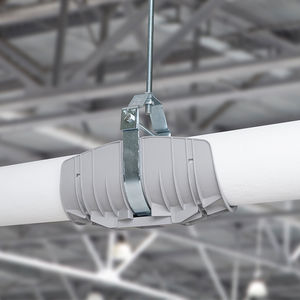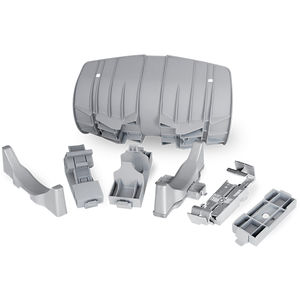An Often-overlooked, but Critical Consideration for all Plumbing, HVAC and Refrigeration Applications
By Kartik A Patel - Technical Services Manager Advanced Insulation Armacell
In cooperation with Martin Boudreau - Business Development Manager Insuguard
 When installing and maintaining pipe systems, the right combination of insulation, vapor retarder, and support system minimizes energy loss, maintains the pipe’s structural integrity, and keeps the pipe system in place. However, get even one component wrong, and you risk substandard system operation and/or expensive repairs. Of interest for this paper is pipe suspension and mounting systems, including the characteristics that will ensure the pipe systems best operation and avoid costly damage.
When installing and maintaining pipe systems, the right combination of insulation, vapor retarder, and support system minimizes energy loss, maintains the pipe’s structural integrity, and keeps the pipe system in place. However, get even one component wrong, and you risk substandard system operation and/or expensive repairs. Of interest for this paper is pipe suspension and mounting systems, including the characteristics that will ensure the pipe systems best operation and avoid costly damage.
Pipe suspension and mounting
Pipe suspension and mounting systems aim to support the weight of a pipe by transmitting the load or forces to the adjacent structure. At the same time, these systems need to avoid damaging the pipe insulation at the contact points, especially during the severe linear movements that pipes can undergo due to thermal expansion and contraction.
To most, the support of pipes is a detail that goes unnoticed. However, in some larger installations such as supermarkets, pipe runs can be at least a mile (1.6 km) long, simultaneously introducing more potential failure points but also presenting an opportunity for the building owner to protect their investment by ensuring the use of appropriate supports.
Common Pitfalls
For any pipe length, from short to long runs, damaged insulation and pipes compromise energy delivery, counteracting the energy and cost savings from the installation of new, energy-efficient heating, air conditioning, or refrigeration equipment.
Potential issues with pipe suspension or mounting systems include shifting/falling saddles, condensation and mold growth, freezing and thawing, refrigerant leaks, insulation tear-off, and inefficient labor and material use.
With normal pipe movement and expansion, saddles can slip out of place, exposing the insulation to pressure and compression. Insulation compression is also possible with inappropriate saddle sizes (Image 1). For heating systems, BTUs are lost at the contact points. For all cold systems, condensation can cause moisture in the insulation, ice formation, and premature corrosion of the pipe inside the insulation (Image 2). Also, with some saddle systems, moisture can collect in the crevice between the support and pipe, increasing the likelihood of rust formation. When supports fail or fall, the insulated pipe run is no longer protected from friction at the support points (Image 3). This can tear the insulation leaving critical lines exposed. If these lines are inside a chase, the problem can go undetected causing condensation or water damage but also making mechanical systems underperform.
Unsecured saddles have even been known to fall from the suspension system, creating serious safety and liability concerns (Image 4).
Insulation and/or vapor barrier damage also occurs from direct contact with a pipe support, particularly with the sharp edges of metal supports (Image 5), or direct contact with the threaded rod attaching the support – creating friction during pipe expansion or vibration. When the pipe insulation is crushed or torn, thermal bridging can occur, negating the value of the insulation.
Optimal Characteristics
With some upfront planning and strategic equipment choices, these issues can be avoided. To be assured of the long-term efficiency, stability, and safety of pipe systems, look for the following pipe support characteristics:
- Complete support of the pipe system (minimum 12 in / 300 mm length)
- Ease of installation and maintenance, with few parts, especially parts that could be replaced with incorrect sizes/materials
- Ability to attach to any suspension or mounting system, regardless of size, including struts, steel angles, H-beams / I-beams, floor mounts, and Clevis hangers
- Sliding design at both ends to prevent insulation damage due to pipe expansion and vibration
- Suitable for inside and outside applications and resistant to UV rays
- Appropriate operating temperature ranges for the application
- Compliance with building codes
- Easily available datasheets and drawings from the manufacturer
- Tested according to ASTM E84/UL 723 standards for fire safety and ULC-S102.2
For aesthetic purposes, the following might also be important:
- Mechanical properties are not altered by painting
- Product maintains the appearance, cleanliness, and professionalism of standard pipe runs
Finally, proper installation is critical. Care should be taken to specify, size, install and support piping securely, but in a way that allows for natural pipe contraction and expansion. There are pipe saddle systems that achieve this and are faster to install.
 Summary
Summary
A well-designed pipe suspension or mounting system protects the insulated pipe by spreading the load over a wider area, greatly reducing insulation compression from the combined pipe and fluid weight and prevents tearing and damage to the insulation and/or vapor retarder caused by thermal linear expansion and vibration. Consider the product and installation characteristics during the planning phase of your pipe system to ensure a good design and avoid unwanted issues.
Armacell Insuguard® saddles and shields eliminate the need for tools, simply clicking in place to connect to any type of suspension or mounting system, regardless of size. Pipe movement is accommodated without compromising the insulation or displacing the saddle, with a design that includes rounded edges that curve away from the pipe at both ends. Footnote 1: Copper Tube Handbook, www.copper.org WHITE PAPER 3 Insulation is damaged when pipe supports fail
Download white paper here.

